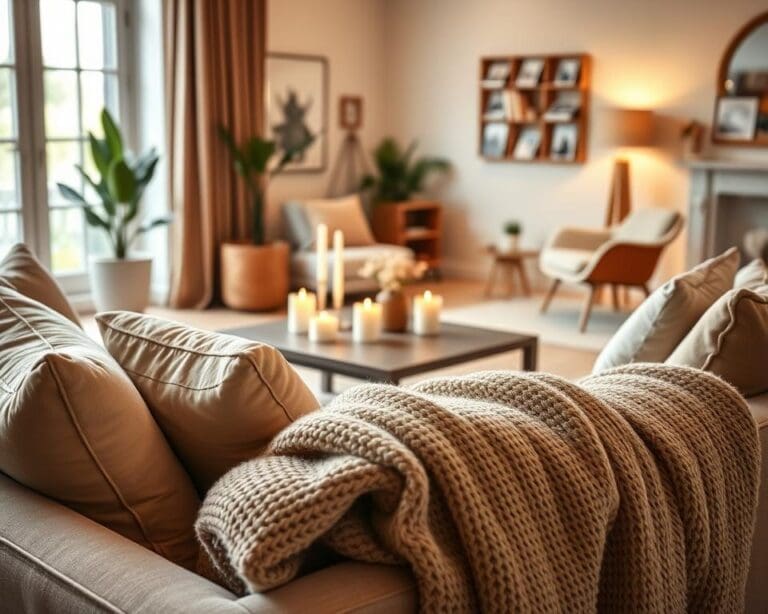Imagine stepping into a home that envelops you in warmth and comfort, a place where you feel instantly at ease. This is the essence of gezelligheid, a Dutch concept that embodies the feeling of being cozy and content in your own space.
A cozy home is more than just a physical structure; it’s an atmosphere that welcomes you to relax, unwind, and be yourself. It’s about creating a warm atmosphere that nurtures both body and soul.
In this article, we’ll explore the elements that contribute to making a house feel like a home, filled with gezelligheid. We’ll delve into practical tips and ideas to help you cultivate a cozy environment that you’ll love coming back to.
Key Takeaways
- Understand the concept of gezelligheid and its role in creating a cozy home.
- Discover simple ways to introduce warmth and comfort into your living space.
- Learn how to balance aesthetics and functionality for a welcoming atmosphere.
- Explore the importance of lighting and color in setting the tone for coziness.
- Find out how to make your home a reflection of your personality and style.
The Essence of “Gezelligheid”: Understanding Coziness in Your Home
In the heart of Dutch culture lies the concept of ‘gezelligheid,’ a term that embodies the warmth and coziness of home, making it a universal language of comfort. It’s about creating an atmosphere that feels inviting, warm, and snug, a notion that resonates deeply with the idea of hygge in Danish culture.
Gezelligheid is more than just a feeling; it’s an experience that combines physical comfort with emotional warmth. So, what makes a house feel like a home? It’s the little things that add up to create a sense of belonging and coziness.
What Makes a House Feel Like a Home
A home that feels cozy is often filled with personal touches, such as family photos, heirlooms, and comfortable furnishings that invite relaxation. These elements work together to create a sense of warmth and welcome.
The Psychology Behind Comfortable Spaces
The psychology behind comfortable spaces reveals that our surroundings significantly impact our mood and well-being. Spaces that are designed to be cozy and inviting can enhance feelings of happiness and relaxation.
Cultural Perspectives on Home Comfort
Cultures around the world have their own interpretations of home comfort. For instance, the Danish concept of hygge emphasizes the importance of coziness and warmth during the cold winter months, while ‘gezelligheid’ in Dutch culture is about enjoying the simple pleasures of life with loved ones.
Understanding these cultural nuances can help in creating a home environment that feels truly cozy and inviting, embodying the essence of ‘gezelligheid’ and enhancing home comfort and cozy living.
Creating Warmth Through Thoughtful Lighting
Lighting plays a crucial role in setting the tone for a warm and welcoming home. A well-designed lighting plan can significantly impact the ambiance of a room, making it feel cozy and inviting.
Layered Lighting Techniques for Different Moods
To achieve the perfect ambiance, consider using layered lighting techniques. This involves combining different light sources, such as overhead lighting, table lamps, and floor lamps, to create a visually appealing and functional lighting scheme.
For example, you can use bright lighting for tasks like reading or cooking, while dimmer lighting can create a relaxing atmosphere for unwinding.
Choosing the Right Light Bulbs for Ambiance
The type of light bulb used can greatly affect the ambiance of a room. Warm white bulbs (2700K-3000K) can create a cozy, warm glow, while cool white bulbs (3500K-5000K) can produce a brighter, more energizing light.
Strategic Placement of Lamps and Light Sources
The placement of lamps and light sources is crucial in creating a warm and welcoming atmosphere. Consider placing lamps in corners or against walls to create pools of warm light, making the space feel cozier.
Candles and Natural Light Enhancement
In addition to artificial lighting, candles and natural light can also enhance the ambiance of a room. Candles can add a warm, soft glow, while maximizing natural light can make a room feel more spacious and welcoming.
By incorporating these lighting techniques, you can create a warm and inviting atmosphere in your home, making it the perfect haven for relaxation and connection.
Textile Touches: Soft Furnishings That Invite Comfort
The essence of coziness lies in the textures and warmth that textiles bring to a space. Soft furnishings such as rugs, throw blankets, and pillows are not just decorative elements; they are crucial in creating an inviting atmosphere that makes a house feel like a home.
Selecting Cozy Textiles for Every Season
Choosing the right textiles for your home involves considering the season. For colder months, opt for thick, plush materials like wool or fleece. In warmer seasons, switch to lighter fabrics such as cotton or linen. This seasonal adjustment not only enhances comfort but also keeps your decor fresh and relevant.
Textile Tips for Different Seasons:
- Winter: Velvet, wool, and thick knits
- Spring: Light cotton, pastel-colored fabrics
- Summer: Linen, silk, and breezy cottons
- Autumn: Warm wools, earth-toned fabrics
Layering Techniques for Ultimate Comfort
Layering different textiles can significantly enhance the coziness of a room. Start with a base layer like a rug, then add throw blankets and pillows in complementary textures and colors. This layering not only adds visual interest but also creates a tactile experience that invites relaxation.
“Layering textiles is an art that can transform a space from cold and sterile to warm and inviting.”
Budget-Friendly Textile Updates
Updating your textiles doesn’t have to be expensive. Look for budget-friendly options like discount stores or online sales. You can also repurpose old textiles by dyeing or reupholstering them. Simple changes like new pillow covers or a throw blanket can make a significant difference.
| Textile | Budget-Friendly Options |
|---|---|
| Pillows | DIY covers, thrift store finds |
| Throws | Discount stores, old sweater repurposing |
| Rugs | Clearance sales, indoor/outdoor rugs |
Practical Tips for Maintaining Soft Furnishings
To keep your textiles looking their best, regular maintenance is key. Vacuum rugs and upholstered furniture regularly, and wash throw blankets and pillow covers according to their care labels. For delicate items, consider professional cleaning.
By incorporating these textile touches and maintaining them properly, you can ensure your home remains a cozy and inviting space throughout the year.
Color Psychology: Palettes That Create Warmth
Color psychology plays a crucial role in home design, influencing how we perceive and feel about our living spaces. The right color palette can evoke feelings of warmth and comfort, making a house feel like a home.
Warm vs. Cool Colors
Colors are generally categorized into warm and cool colors. Warm colors like red, orange, and yellow tend to evoke warmth and energy, while cool colors such as blue, green, and purple can create a calming effect. In the context of home design, warm colors are often used to create cozy and inviting spaces.
Creating Color Harmony
Achieving color harmony is essential for a visually appealing and cozy home. This can be done by selecting a palette that complements the architectural style of your home and the natural surroundings. Using different shades of a single color or combining complementary colors can also create a harmonious atmosphere.
| Color Type | Examples | Effect on Ambiance |
|---|---|---|
| Warm Colors | Red, Orange, Yellow | Evokes warmth and energy |
| Cool Colors | Blue, Green, Purple | Creates a calming effect |
Easy Color Updates
Updating your home’s color scheme doesn’t always require a fresh coat of paint. You can introduce new colors through furniture, rugs, and decorative items. This approach allows for flexibility and ease in changing the ambiance of your home as desired.
Regional Color Preferences
Regional preferences can influence the choice of colors for homes. For instance, in colder climates, warm and rich colors are often preferred to create a cozy atmosphere, while in warmer regions, lighter and cooler colors can help keep homes feeling fresh and airy.
Hoe maak je een huis vol gezelligheid? Through Personalized Decor
The essence of making a house feel like a home lies in the personalization of your decor, turning it into a reflection of your personality and experiences. Personalized decor is not just about filling your space with items; it’s about curating a selection that resonates with you and your family’s story.
Displaying Meaningful Items and Memories
Displaying personal and meaningful items is a powerful way to add coziness to your home. This can include family photos, heirlooms, or souvenirs from travels. These items not only add visual interest but also serve as reminders of cherished memories. When choosing items to display, consider their sentimental value and how they contribute to the overall ambiance of your home.
Balancing Personal Touches with Design Principles
While personalization is key, it’s equally important to balance your personal touches with sound design principles. This means considering the scale, color, and texture of the items you choose to display. A well-balanced space feels harmonious and visually appealing. For instance, mixing vintage pieces with modern decor can create a unique and inviting atmosphere.
Creating Conversation Pieces That Tell Your Story
Your home decor should be a reflection of your story. Incorporating conversation pieces—items that spark interest and tell a story—can add depth and warmth to your space. This could be a vintage artifact, a piece of local art, or a handmade item. These pieces not only personalize your space but also invite connection and conversation.
Rotating Seasonal Decor for Fresh Coziness
To keep your home feeling fresh and cozy, consider rotating your decor seasonally. This doesn’t mean a complete overhaul; simple changes like switching throw pillows, adding seasonal flowers, or incorporating seasonal colors can make a significant difference. Rotating decor keeps your space feeling dynamic and engaging throughout the year.
By thoughtfully curating your decor and balancing personal touches with design principles, you can create a home that feels truly cozy and inviting. It’s about making your space a reflection of you and your experiences, making it a place where memories are made and cherished.
The Power of Scent: Creating an Inviting Atmosphere
The power of scent is often underestimated in home decor, yet it has the ability to transform a space entirely. Scents can evoke emotions, stimulate memories, and significantly influence the ambiance of a home.
One of the most effective ways to create an inviting atmosphere is through the use of natural scents. Essential oils derived from plants, flowers, and herbs can be used in diffusers or mixed with water for a refreshing spray. This not only freshens the air but also adds a layer of coziness to your home.
Natural Scent Solutions for Your Home
Natural scent solutions include using essential oils, simmering spices on the stove, or incorporating fragrant flowers into your decor. These methods provide a subtle yet inviting aroma that makes your home welcoming.
Seasonal Fragrances to Enhance Coziness
Seasonal fragrances can significantly enhance the coziness of your home. For example, during winter, scents like cinnamon and pine can create a warm and cozy atmosphere, while spring might call for fresher scents like lavender or lemon.
| Season | Recommended Scents |
|---|---|
| Winter | Cinnamon, Pine, Vanilla |
| Spring | Lavender, Lemon, Eucalyptus |
| Summer | Citrus, Ocean Breeze, Jasmine |
| Autumn | Pumpkin Spice, Apple, Cinnamon |
DIY Scent Projects for Personalized Ambiance
Creating your own scented products can be a fun and rewarding DIY project. You can make your own scented candles, room sprays, or potpourri using natural ingredients. This allows you to tailor the scents to your preferences and the specific ambiance you wish to create.
Avoiding Scent Overwhelm in Smaller Spaces
In smaller spaces, it’s crucial to avoid overwhelming scents. Using subtle, natural fragrances and ensuring good ventilation can help maintain a cozy atmosphere without overpowering the senses.
By thoughtfully incorporating scents into your home decor, you can create a warm and inviting atmosphere that makes your house feel like a home.
Sound Design: The Overlooked Element of Cozy Homes
While visual elements often take center stage in home design, the role of sound in creating a cozy atmosphere is equally crucial. Sound has the power to transform a house into a home, making it feel welcoming and comfortable.
Managing Acoustics for Comfort
Effective sound management starts with understanding the acoustics of your space. This involves minimizing echo and reducing reverberation through the use of sound-absorbing materials like carpets, curtains, and acoustic panels.
Creating Ambient Sound Environments
Ambient sound can significantly enhance the coziness of a home. Techniques include using white noise machines or apps that simulate rain or ocean sounds to create a soothing atmosphere.
Music Selection for Different Home Activities
The right music can complement various activities at home, from relaxation to entertainment. Curating playlists for different occasions can enhance the overall ambiance.
Reducing Unwanted Noise in Your Space
Minimizing external noise is crucial for a cozy home. Strategies include using soundproofing materials and sealing gaps around windows and doors to keep the peace inside.
By incorporating these sound design elements, homeowners can create a more inviting and cozy living environment.
Arranging Furniture for Connection and Comfort
A well-planned furniture arrangement can transform your home into a haven of comfort and warmth. This involves more than just placing furniture in a room; it’s about creating an environment that encourages connection, relaxation, and a sense of togetherness.
Creating Conversation Areas That Encourage Togetherness
To foster connection, it’s crucial to create conversation areas within your home. Arranging seating in a circular formation can facilitate face-to-face interaction, making your living space feel cozier and more inviting.
Balancing Function with Coziness in Small Spaces
In small spaces, balancing functionality with coziness is key. Selecting multi-functional furniture pieces and ensuring a clear path through the room can help. Using light colors and mirrors can also make the space feel larger and more comfortable.
Adapting Spaces for Different Activities and Seasons
Adapting your furniture arrangement for different activities and seasons can keep your home feeling fresh and cozy. For example, rearranging your living room for holiday gatherings or creating a cozy reading nook for winter can enhance the comfort of your home.
Furniture Placement Principles for Maximum Comfort
For maximum comfort, consider the flow of traffic in your home and place furniture to create cozy nooks. Using area rugs and strategic lighting can also enhance the comfort of a room, making it feel more like a haven.
By thoughtfully arranging your furniture, you can create a home that feels cozy, comfortable, and inviting to all who enter.
Conclusion: Embracing Your Unique Vision of Coziness
Creating a cozy home is a personal journey that involves embracing your unique vision of warmth and comfort. As we’ve explored, it’s about more than just aesthetics; it’s about crafting a space that reflects your personality and style.
By incorporating thoughtful lighting, soft furnishings, and personalized decor, you can create a warm and welcoming atmosphere that makes your house feel like a home. Remember, coziness is not just about visual appeal; it’s also about engaging your senses with inviting scents, soothing sounds, and comfortable textures.
As you work on making your house a cozy home, don’t be afraid to experiment and try new things. Your unique vision of coziness is what will make your space truly special. By balancing comfort and functionality, you’ll create a cozy home that feels like a haven, a place where you can relax, recharge, and connect with loved ones.








